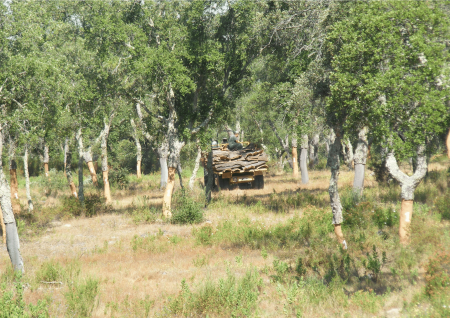
Objective:
This project aims to assess the effects of FSC certification on the conservation of cork oak woodlands namely how certified conservation zones (areas of lower management intervention) affect oak natural regeneration, understory shrub diversity, conservation of water streamlines and associated bird diversity. In addition, at a larger scale, the project also aims to identify geographical areas of conservation value for biodiversity and ecosystem services. Resulting information will contribute to identify target areas to implement payment for ecosystem services schemes using FSC certification as a validating tool of good management practices.
Context:
FSC certification is expanding globally into different forest ecosystems but its effects on conservation still needs empirical testing. This lack of information drove the idea of quantifying the potential effects of certification on the conservation of cork oak woodlands. Additionally, we wanted to assess if certification is a good proxy of “sustainable forest management”. This rationale is the basis of a concept of payment for ecosystem services scheme developed by the School of Agriculture (Centre for Applied Ecology) of the University of Lisbon, WWF and the Forest Producers Association of Coruche in Portugal.
Contacts:
Miguel Nuno Bugalho, migbugalho@isa.ulisboa.pt, http://www.isa.ulisboa.pt/ceabn/content/1/80/homepage
Further information:
Bugalho MN, Dias FS, Briñas B, Cerdeira JO (2015). Using the high conservation value concept and Pareto optimization to identify areas maximizing biodiversity and ecosystem services in cork oak landscapes. Agroforestry Systems 90: 35-44 (doi: 10.1007/s10457-015-9814-x)
Bugalho MN, Lecomte X, Gonçalves M, Caldeira MC, Branco M (2011) Establishing grazing and grazing‐excluded patches increases plant and invertebrate diversity in a Mediterranean oak woodland. Forest Ecology and Management 261: 2133-2139 (DOI: 10.1016/j.foreco.2011.03.009)
Bugalho MN, Silva LN (2014). Promoting sustainable management of cork oak landscapes through payments for ecosystem services: the WWF Green Heart of Cork project. Unasylva 242: 29-33 (http://www.fao.org/3/a-i3837e.pdf)
Caldeira MC, Ibáñez I, Nogueira C, Bugalho MN, Lecomte X, Moreira A, Pereira JS (2014). Direct and indirect effects of tree canopy facilitation in the recruitment of Mediterranean oaks. Journal of Applied Ecology 51: 349-358 (DOI: 10.1111/1365-2664.12189)
Dias FS, Miller DL, Marques TA, Marcelino J, Caldeira MC, Cerdeira JO, Bugalho MN (2016). Conservation zones promote oak regeneration and shrub diversity in certified Mediterranean oak woodlands. Biological Conservation 195: 226-234 (DOI: 10.1016/j.biocon.2016.01.009)
Dias F, Bugalho MN, Rodríguez-González P, Albuquerque A, Cerdeira, JO (2014). Effects of forest certification on the ecological condition of Mediterranean streams. Journal of Applied Ecology 52: 190-198 (DOI: 10.1111/1365-2664.12358)
Lecomte X, Caldeira MC, Catry FX, Fernandes PM, Jackson RB, Bugalho MN (2018) Ungulates mediate tradeoffs in C storage and wildfire hazard in Mediterranean oak woodlands. Journal of Applied Ecology (DOI: https://doi.org/10.1111/1365-2664.13310)
Vaz PG, Bugalho MN, Fedriani JM, Branco M, Lecomte X, Nogueira C, Caldeira MC, (2019) Unravelling associations between tree-seedling performance, herbivory, competition, and facilitation in high nature value farmlands. Journal of Environmental Management 232: 1066–1074 (DOI:10.1016/j.jenvman.2018.11.082)
Link: www.habeas-med.org